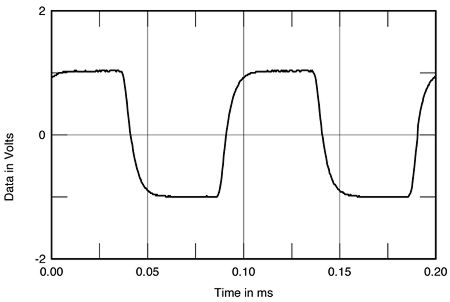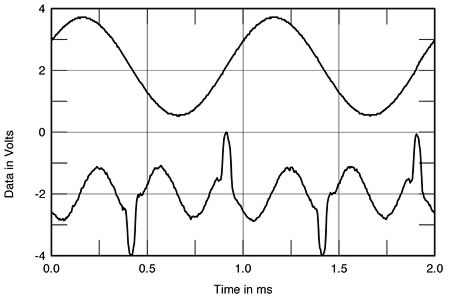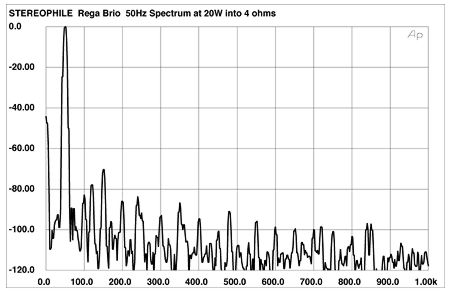| Columns Retired Columns & Blogs |
Rega Brio integrated amplifier Measurements
Sidebar 2: Measurements
All of the following measurements, except as noted, were taken with the level control set to a position at which an input of 100mV results in an output of 1W (approximately 2:00 o'clock). The overall gain at this position is 29.2dB; the Brio's gain with the level control full up is 40dB.
The Rega Brio was warm, but not hot, following its 1-hour, 1/3-power preconditioning test. Its line input impedance measured 65.5k ohms at 1kHz, a comfortably high value. At lower and higher settings of the level control this value increased marginally to 69.6k ohms at 9:00, and to 72.2k ohms at maximum rotation. The input impedance at the phono input was 46.8k ohms in the left channel, 47.3k ohms in the right. The Rega's output impedance was comfortably low: under 0.033 ohms up to 1kHz, increasing to a maximum of 0.21 ohms at 20kHz. The source impedance at the tape outputs measured 987 ohms with a 25 ohm or 600 ohm source impedance, indicating the presence of buffered amplifiers. DC offset at the main outputs measured a negligible 2.2mV in the left channel, 1.4mV in the right.
The signal/noise ratio (unweighted ref. 1W into 8 ohms) was 73.8dB with a 22Hz-22kHz bandwidth, 69.8dB with a 10Hz-500kHz bandwidth, and 76.3dB A-weighted. The latter decreased to 68.7dB with the level control at maximum, and increased to 78.8dB with it at minimum. The corresponding phono-stage S/N, ref. 1V, measured 88dB (22Hz–22kHz), 77.1dB (10Hz–500kHz), and 91.2dB (A-weighted). The gain of the phono stage from the phono input to the tape output was 31dB. The Rega is inverting from its line input to its main outputs, and noninverting from phono input to tape output.
The Brio's volume-control tracking was reasonable—an important consideration where there is no balance control. The two channels differed from one another by a maximum of 0.39dB at 12:00.
Fig.1 shows the Brio's frequency response. The variation with changes in load is visible but not very significant. The –2dB loss of deep bass in the 20–25Hz region should not be noticeable with the sort of loudspeakers likely to be used with this amplifier. The phono equalization indicates a small shelved rolloff that extends across most of the high-frequency range, which may result in a very subtle lack of sparkle on LP. Fig.2 is the Rega's output with a 10kHz squarewave input. The rise-time is good. The small degree of rounding of the leading corners is predictable from the frequency response, but there's no overshoot or ringing. The 1kHz squarewave response, not shown, indicates only a small backtilt to the top and bottom edges, also consistent with the frequency response.

Fig.1 Rega Brio, frequency response at (from top to bottom at 3kHz): phono stage RIAA error; line input response at 2W into a simulated loudspeaker load; 1W into 8 ohms, 2W into 4 ohms, and 1W into 8 ohms with the volume control set to -20dB (0.5dB/vertical div., right channel dashed).

Fig.2 Rega Brio, small-signal 10kHz squarewave into 8 ohms.
Fig.3 plots the Brio's crosstalk, a good result for both the phono and line stages. There is close agreement between the channels, and the usual increase at higher frequencies typically due to interchannel capacitive coupling.

Fig.3 Rega Brio, crosstalk (from top to bottom at 1kHz): R-L, L-R, line; L-R. R-L, phono (10dB/vertical div.).
The THD+noise vs frequency results in fig.4 are satisfactory but not spectacular, with rises in distortion apparent at higher frequencies and lower-impedance loads. We see here the first sign that the Rega really is not designed to drive loads of less than 8 ohms. Fig.5 shows the THD+noise output waveform of the Rega (at 1kHz) driving 5W into a 4 ohm load. There is a largely third-harmonic result, along with some unusual spikes cropping up at a second-harmonic rate. The latter, which also appear in the 8 ohm and 2 ohm results (not shown), might add some roughness to the sound. The THD+noise readings for the phono stage (also shown in fig.4) were performed with an input of 10mV and taken at the tape outputs. Most of the result indicated here is actually noise. To reach the absolute minimum THD+noise of the phono stage requires an input of 197mV at 1kHz (a reading of 0.0063% THD+noise)—an academically interesting but hardly typical level.

Fig.4 Rega Brio, THD+noise vs frequency at (from top to bottom at 10kHz): 4W into 2 ohms, 2W into 4 ohms, 2W into simulated speaker load, 1W into 8 ohms, and phono stage at 10mV/1kHz (right channel dashed).

Fig.5 Rega Brio, 1kHz waveform at 5W into 4 ohms (top), distortion and noise waveform with fundamental notched out (bottom, not to scale).
The Rega Brio's phono-stage overload point (1% THD+noise) was 273mV at 1kHz (34.7dB above the 5mV reference), 2.73V (34.7dB) at 20kHz, and 15.8mV (35.8) at 20Hz. All of these are excellent figures.
Fig.6 shows the spectrum of the Rega's output driving 50Hz at 20W into a 4 ohm load. The largest artifact is the third harmonic (150Hz) at –70.3dB (about 0.03%). The intermodulation in the output caused by a combined 19+20kHz input at 16W into 4 ohms (just prior to clipping with this input signal) is indicated in fig.7. Here the IM products at 1kHz and 2kHz are –64dB (0.06%) and –66dB (0.05%), respectively, while the largest artifact is at 18kHz (–29.8dB, or about 3%). The corresponding values for a power output of 16W into 8 ohms (not shown) are –80dB (0.01%) at 1kHz, –77dB (about 0.015%) at 2kHz, and –37dB (about 1.5%). Again, it's clear that the Rega is most happy with an 8 ohm load.

Fig.6 Rega Brio, spectrum of 50Hz sinewave, DC–1kHz, at 20W into 4 ohms (linear frequency scale).

Fig.7 Rega Brio, HF intermodulation spectrum, DC–24kHz, 19+20kHz at 16W into 4 ohms (linear frequency scale).
Fig.8 shows the Brio's THD+noise plotted against output power with one channel driven, at 1kHz. The power supply begins to run out of gas at lower impedances, with slightly lower output power into 4 ohms than into 8, and considerably less into 2 ohms. The discrete clipping measurements (1% THD+noise at 1kHz), to the nearest watt, are shown in Table 1.

Fig.8 Rega Brio, distortion (%) vs continuous output power into (from bottom to top): 8 ohms, 4 ohms, and 2 ohms (one channel driven).
Table 1 Clipping power (1% THD+noise at 1kHz)
| Both Channels Driven | One Channel Driven | ||
| Load | W (dBW) | W (dBW) | |
| ohms | (L) | (R) | |
| 8 | 28 (14.5) | 28 (14.5) | 33 (15.1) (L) |
| line V | 114 | 113 | 113 |
| 4 | 27 (11.2) | 31 (11.8) | 29 (11.6) (L) / 36 (12.5) (R) |
| line V | 113 | 113 | 114 |
| 2 | 11 (4.4) (L) | ||
| 113 | |||
JA also checked the Brio's power output under dynamic conditions, using the Miller Audio Research Amplifier Profiler. Fig.9 shows the envelope of the Brio's output power into 8 ohms (black), 4 ohms (red), 2 ohms (blue), and 1 ohm (green), using a 1kHz toneburst signal with 10 cycles on and 40 cycles off to simulate the effect of music. The horizontal magenta line indicates distortion at the -40dB level (1%), which we define as the clipping point. With this toneburst signal (one channel driven), 40W is available into 8 ohms compared with 33W on a continuous basis. But only 31.7W is available into 4 ohms, 11.5W into 2 ohms, and just 3.5W into the punishing 1 ohm load. As the earlier results indicated, the Rega is not happy with low impedances.

Fig.9 Rega Brio, distortion (dB) vs dynamic output power into 8 ohms (black), 4 ohms (red), 2 ohms (green), and 1 ohm (blue) (one channel driven).
Fig.10 shows the output voltage rather than power, again measured using the 1kHz toneburst signal. Each time the load impedance halves, the maximum voltage available drops dramatically. One interesting point is that the looking at the signal waveform on the oscilloscope screen as this test was being performed revealed that it wasn't actually clipped at the 1% point. Instead, the sinewave started to triangulate. When the waveform did actually clip, this was at the 3% level and the negative-going peaks were chopped off before the positive-going peaks.

Fig.10 Rega Brio, distortion (dB) vs dynamic output voltage into 8 ohms (black), 4 ohms (red), 2 ohms (green), and 1 ohm (blue) (one channel driven).
In general, the Rega Brio is, from a measurement standpoint, a competent but not exceptional performer.—Thomas J. Norton
- Log in or register to post comments




































